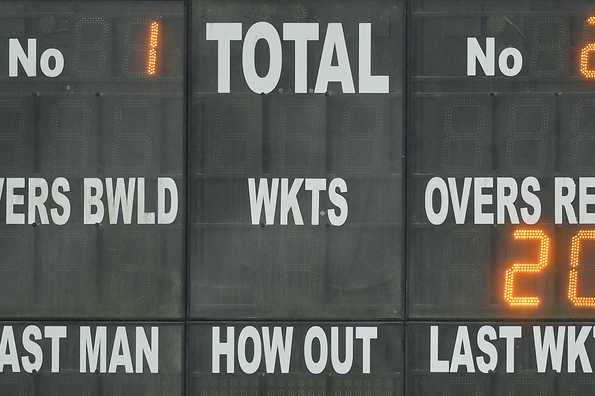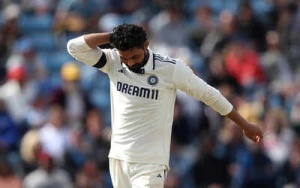The International Cricket Council (ICC) has announced adjustments to the Playing Conditions for Twenty20 Internationals (T20Is), with the most significant change affecting PowerPlay calculations. Specifically, the duration of the PowerPlay will now be determined by rounding to the nearest ball, rather than the nearest over.

Under the previous rules, the initial six overs constituted the PowerPlay, typically representing 30% of a standard 20-over innings. However, when innings were shortened, rounding to the nearest over could lead to disproportionate allocations.
When the batting team's overs are reduced, the number of Powerplay overs will be adjusted according to the following table. This table applies to both the first and second innings of a match:
| Match reduced (overs) | Powerplay overs |
|---|---|
| 5 | 1.3 |
| 6 | 1.5 |
| 7 | 2.1 |
| 8 | 2.2 |
| 9 | 2.4 |
| 10 | 3 |
| 11 | 3.2 |
| 12 | 3.4 |
| 13 | 3.5 |
| 14 | 4.1 |
| 15 | 4.3 |
| 16 | 4.5 |
| 17 | 5.1 |
| 18 | 5.2 |
| 19 | 5.4 |
For example, an 8-over innings previously included two PowerPlay overs, while a 9-over innings had three. Under the new system, these will be adjusted to 2.2 and 2.4 overs respectively, maintaining a proportion closer to 30%.
The ICC stated, "This table has been used in the T20 Blast in England for many years, where ending a PowerPlay midway through an over has caused no difficulty for players or officials. It has now been accepted by the ICC Men's Cricket Committee as the preferred method moving forward." In the 8-over example, the umpire will signal the end of the PowerPlay after 2 balls of the 3rd over, allowing three additional fielders to move outside the inner circle.
The ICC has also mandated that concussion replacements in Men's T20I matches must be identified and named before the start of the match. This aims to ensure fairness by eliminating the home team's advantage of having a larger pool of available players. Teams are required to nominate the following concussion replacements to the match referee:
The ICC acknowledged that Associate Member teams may face challenges in identifying five specific concussion replacement players for every match, particularly when playing overseas. To address this, the system for Associate Member T20Is will be adjusted accordingly.
Teams can nominate a batter as the replacement wicketkeeper. However, the referee may require the nominated batter to keep wicket if used as the replacement, or allow another player from the starting XI to keep wicket at their discretion. The goal is a like-for-like replacement, not to gain an advantage with an extra batter.
The same player can be nominated for multiple categories. For instance, if an all-rounder is nominated for multiple positions and replaces a batter, the referee may restrict them from bowling as they are designated as a batter replacement. Concussion replacements are not restricted to the playing squad; teams can nominate any eligible player.
The overarching principle remains a like-for-like concussion replacement, with the referee having the discretion to determine if a replacement player is sufficiently similar to the injured player.
The ICC also addressed the use of saliva on the ball. The new regulations state that if any substance, including saliva, is used to alter the ball's condition, the ball must be replaced. This prevents teams from deliberately applying saliva to trigger an automatic ball change.
These changes currently apply only to the Men's playing conditions. The Women's playing conditions will be updated in October. The new playing conditions will take effect on July 10, 2025.
Newer articles
Older articles
 Moto G54 Gets Significant Price Cut in India, Making Budget Smartphone Even More Appealing
Moto G54 Gets Significant Price Cut in India, Making Budget Smartphone Even More Appealing
 Africa's Rift Valley: Mantle Upwelling Drives Continent's Split and Birth of New Ocean
Africa's Rift Valley: Mantle Upwelling Drives Continent's Split and Birth of New Ocean
 X Cracks Down: Over Half a Million Indian Accounts Suspended for Policy Breaches
X Cracks Down: Over Half a Million Indian Accounts Suspended for Policy Breaches
 Vijay Sethupathi Apologizes Amid Controversy Over Son Surya's Debut Film 'Phoenix'
Vijay Sethupathi Apologizes Amid Controversy Over Son Surya's Debut Film 'Phoenix'
 Jadeja's Accuracy Questioned: Ex-India Pacer Slams Spin Strategy in England Test Loss
Jadeja's Accuracy Questioned: Ex-India Pacer Slams Spin Strategy in England Test Loss
 IRCTC's AI Chatbot Revolutionizes Train Ticket Booking, Refunds, and Information Access
IRCTC's AI Chatbot Revolutionizes Train Ticket Booking, Refunds, and Information Access
 Ashada Gupt Navratri 2025: Unveiling Dates, Sacred Rituals & Hidden Significance of the Monsoon Festival
Ashada Gupt Navratri 2025: Unveiling Dates, Sacred Rituals & Hidden Significance of the Monsoon Festival
 Google Maps Enhances Directional Accuracy with Fused Orientation Provider Update
Google Maps Enhances Directional Accuracy with Fused Orientation Provider Update
 xAI to Open Source Grok, Democratizing Access to Musk's AI Chatbot
xAI to Open Source Grok, Democratizing Access to Musk's AI Chatbot
 Android Users Urged to Patch Now: Critical Security Flaws Expose Devices to Attacks
Android Users Urged to Patch Now: Critical Security Flaws Expose Devices to Attacks